When building a two-story home, it’s standard to put a subfloor down during the building process, and put the finished flooring (whether it be hardwood, carpet, tile, etc.) down toward the end of the project. I chose to ditch the subfloor altogether, and use one layer of hardwood as both my structure and my finished flooring.
Wood is good. I tell my wife that all the time. I absolutely love hardwood floors. In our new home, we were originally planning on carpeting the second story for that cozy feel – especially for the kids bedrooms. However, when I realized the time I would save and the long-lasting quality product I would get with a single layer of hardwood, we decided that area rugs can be cozy, too. Curious how (and why) I ditched the subfloor, and went straight to the hardwood? Read on.
A Typical Two-Story Build with Subfloor + Finished Floor
Typical platform framing requires you to put your subfloor in before your second story walls go up. The subfloor is needed for a couple of reasons:
- It is required for the structure of the home. The subfloor ties your joists together. The second story walls are built on top of the subfloor.
- Because your walls aren’t up yet, you do not have your roof on to protect your subfloor from outdoor elements, like rain and snow. Allowing these elements to hit your subfloor is fine, but not desirable for a finished floor for obvious reasons.
- Building crews aren’t the cleanest or the most careful. (Trust me – I’m one of them.) A finished floor can be easily damaged and dirtied with so much work happening, so it’s usually one of the last things installed (especially carpeting).
My Hardwood Flooring Without Subfloor
I framed my house in a rather unconventional way that allowed my floor joists to be framed in after the enclosure was complete. (See my framing details here.) Because of that, I didn’t have to worry about my second story flooring being exposed to outdoor elements. The space is all enclosed and conditioned. That allowed me to go straight for the hardwood, with no subfloor needed.
I bought unfinished 5” x ¾” long-length tongue and groove white oak flooring. It is a combination of quarter sawn and rift sawn. To me, that means it’s more stable than plain sawn. To my wife, that means there is less grain. We call that a win, win.
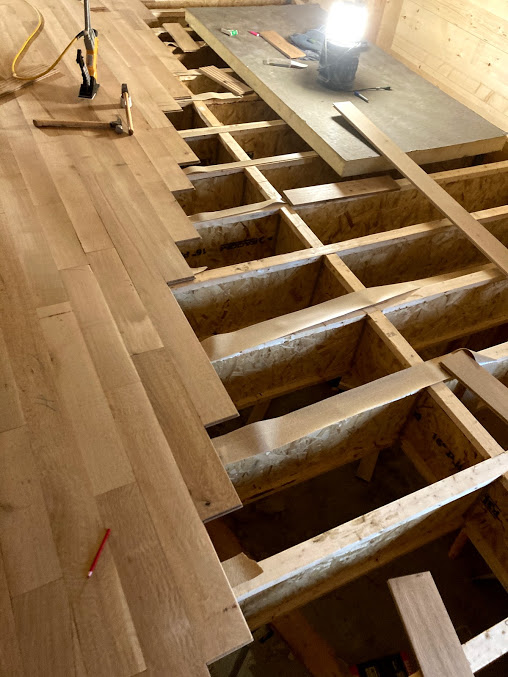
Once the walls are painted, we will sand all of the floors down and finish them with a natural Rubio Monocoat. Rubio Monocoat is a 0% VOC hardwax oil wood finish. Rather than dreading the smell and health hazard of a typical polyurethane finish, I am looking forward to that sweet smell and natural look of the Rubio. For all interested, I’ll be sure to share more details once I get to finishing the floor.
Benefits of Hardwood with No Subfloor
There were just too many good reasons to go this route to even consider anything else.
- The obvious one: not buying subfloor. Saving money is always a plus in my book (…or a minus, I guess).
- Because we installed the flooring before the walls were up, we didn’t have to cut around closets or corners. This significantly decreased our number of cuts and material waste. It also made the process go a lot faster.
- Because our flooring is continuous, we don’t need shoe mold. (Shoe mold typically covers the gap between the flooring and the wall.)
- If we ever want to remodel, we don’t have hardwood flooring to tooth in, because we have a continuous plane.
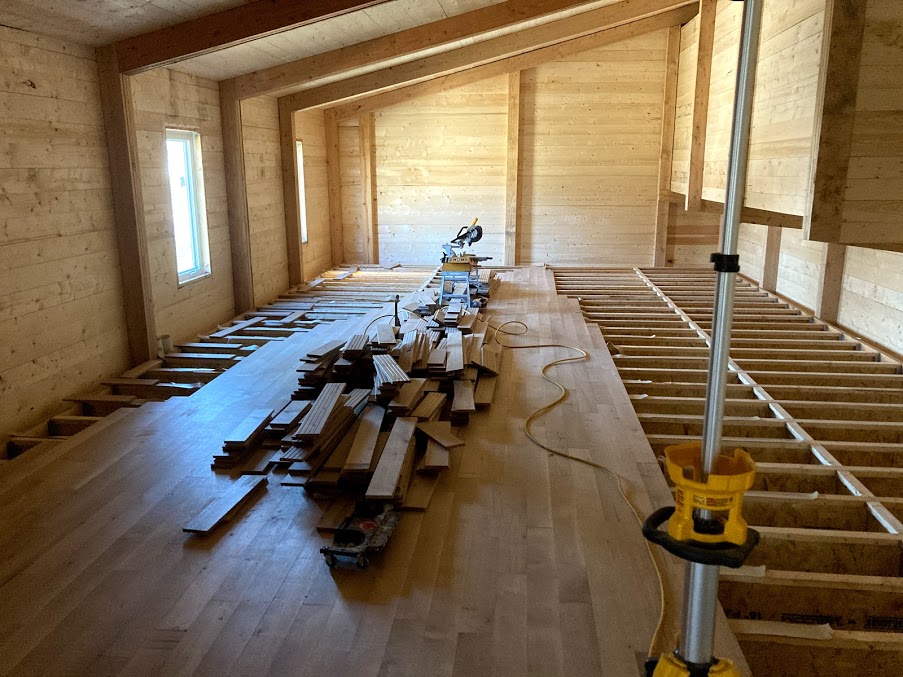
Busting the Myth of Needing Subfloor
For all the naysayers who are doubting this method, I’d like to ease your concern.
- Myth: The noise that you’ll hear on the first floor when people are walking on the second floor will be excessive without subfloor.
- My Solution: I put a sound dampening membrane on all of my joists. My I-joists are 2.5” wide. I got a 3’ roll of sound dampening membrane from Floor and Decor, and cut it into thin strips and applied it between the joist and flooring. So far, there are virtually no squeaks, and it sounds solid. I will also use standard sound barrier insulation between my first and second floor.
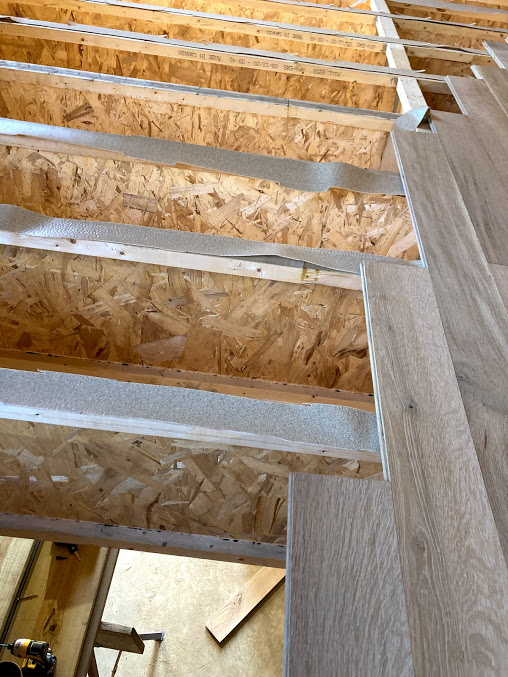
- Myth: The flooring is too weak without a subfloor.
- My Solution: White oak is a hard, dense wood so it’s a great material to start with. Because my joists are 16” on center, all I have is a 13.5” unsupported space between each joist. The wood is all tongue and groove, so it’s really strong.
- Side note: I didn’t even worry about breaking seams on a joist. I broke it wherever it fell. For strength and durability, I just ensured I didn’t have two consecutive breaks in a single joist bay.
- My Solution: White oak is a hard, dense wood so it’s a great material to start with. Because my joists are 16” on center, all I have is a 13.5” unsupported space between each joist. The wood is all tongue and groove, so it’s really strong.
- Myth: Hardwood floor without subfloor won’t have space to expand/contract, and will crack over time.
- My Solution: When I framed my walls, I knew I needed to allow for movement of my flooring. For my sill plate, I drilled an oversized hole, and then I put a ledger lock through that hole into my joist. Therefore, my sill plate is tied into my floor joist and not the hardwood. This means my hardwould can move in that oversized hole to prevent cracking. The floor is not restricted with the walls.
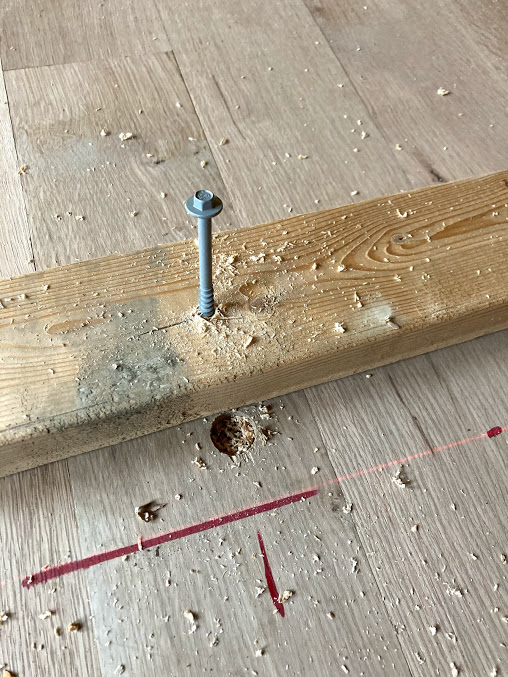
- Myth: This won’t work because I want carpeting in some rooms and tile in others.
- My Solution: You can put carpeting or tile on top of the hardwood if you choose. We plan to tile our second story bathrooms and laundry room. That said, the advantage (and resale value) of having the hardwood on all of the rest of the floors is worth it.
Should You Ditch Subfloors in Your New Build?
I want to make it clear that I’m not advocating for no second story subflooring in all new homes. It takes a specific framing detail and structure for this method to work. That said, if you are building in a way that allows for it, you should absolutely consider it! Save yourself some time and money, and end up with a beautiful floor that will last generations.
Wood is good. Build on!

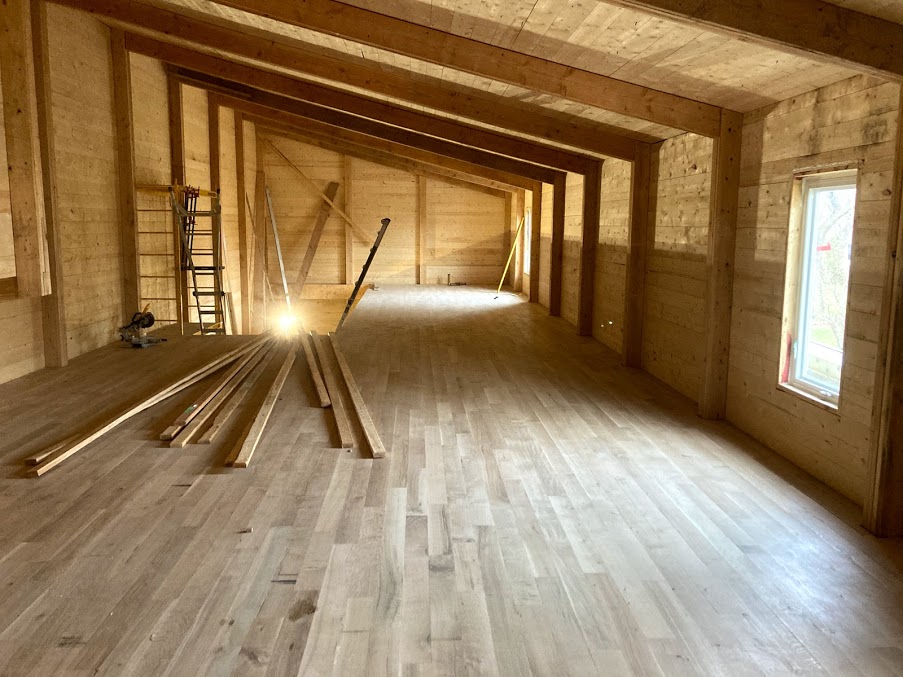
Looking at milling and installing 2″ thick floors in a new construction home – found the specs a subfloor must meet, but not whether or not it is actually required. Any comments from the inspector or code on this that you have found?
Many thanks
Ian
I had no questions from the inspector. The build went really smooth.
I am glad I found your article. I want to redo a floor in an old cobblestone house. I would like to do wide plank Ash flooring. I was thinking about using construction adhesive to glue it to the floor joists, and using deck screws to fasten it. Thinking about grilling a hole, then filling it with a peg. The reason I would like to skip the subfloor, 1 I feel like I don’t need it, 2 is not dealing with the increased from the subfloor, and also the better heat transfer from my in floor heat without having to heat through the subfloor. any downside to doing it this way?
Thanks for reaching out! As long as your ash flooring is tongue and groove with your joists 16″ O.C. you should have no problem. I would only be concerned about moisture below the joists. If its conditioned space you will have no issues. If there is excessive moisture below you will most likely have issues with the moisture drive in your floor assembly. In that case you would be better off using a sub floor with a vapor barrier.
I am about to start construction of a small cabin in the southeast and have been thinking about doing something very similar. Thanks for your thorough explanation. In my case part of the space underneath is conditioned and part of it is sealed/insulated crawl space. Would that change your opinion of the suitability of solid wood floors without a subfloor?
Thanks for reaching out! If the crawl space is sealed and insulated you will have no problem. As long as your vapor barrier and thermal barrier are beneath the flooring it will technically be in the conditioned envelope.